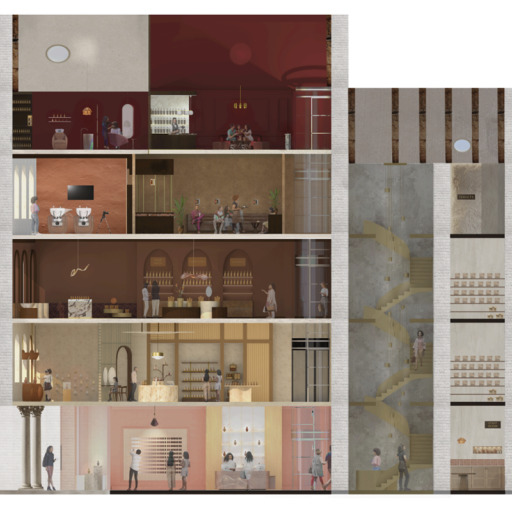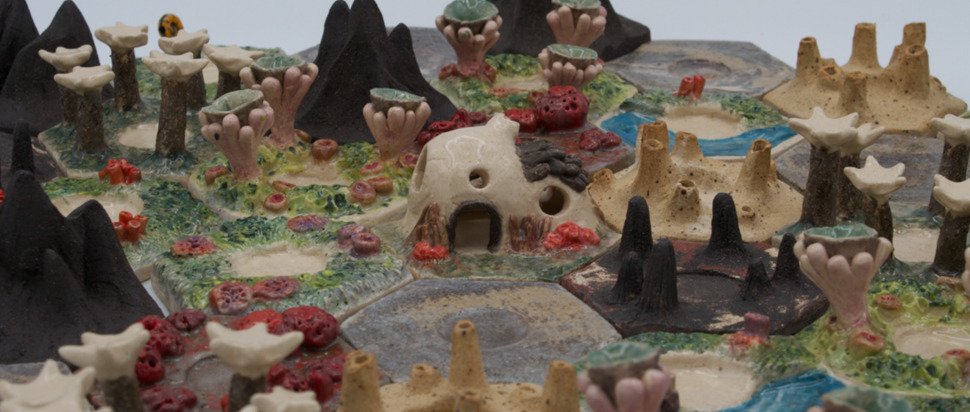GSA Degree Show 2025: Design
At the School of Design, a unifying theme weaves through diverse disciplines, as the Class of 2025 unveil designs that intertwine the personal and the cultural – stories told through form, function, and fearless imagination
The Product Design Engineering programme bridges engineering and design disciplines to develop, build, and test innovative product solutions to real-world challenges. Jake Lee’s project tackles the petrochemical waste produced within the surfing industry by replacing traditional foams and resins with sustainably sourced, natural alternatives. Lee’s beginner surfboard features an engineered industrial moulding process for a mycelium composite core and the rest of the natural board. The result is an entirely natural board that can completely biodegrade.
Sophie Willis looks at protecting the marine habitats in Scotland, which, despite their importance, often fall to community organisations and citizen scientists for research and preservation. To support these efforts, Willis is developing a data collection device that bridges the gap between prohibitively expensive research equipment and the more affordable but time-intensive methods currently available. Killian Maguire proposes an alternative approach to communal music listening by disconnecting from personal smartphones, which are poorly adapted to shared social environments. His streaming controller facilitates a more collaborative and haptic mode of engagement, fostering social connection through the shared use of a physical device.
Driven by vision and purpose, this year’s Interior Design graduates transform Glasgow’s derelict buildings into vibrant catalysts for urban renewal. Barsha Poudel’s project, Grow and Gather Hub, embodies this spirit of transformation. Rooted in the desire to bring farming closer to urban life, it reimagines Glasgow’s historic rotundas as vibrant centres for growing, learning, and community engagement. The project bridges the gap between city living and sustainable food production, creating a dynamic environment where people of all ages can reconnect with nature through hands-on farming, educational workshops, and shared experiences.

Jake Lee, Product Design Engineering
Sophia Cavalluzzi's work envisions an evolving digital detox facility that offers users immersive, anatomy-inspired experiences designed to promote a full-body reset from the relentless pace of the digital world. The project is founded by Sono the Collective, a global design studio committed to creating experiences that address the darker impacts of the digital age for the benefit of human well-being. The detox facility is located within the Botanic Gardens Railway, extending nearly one kilometre through this unique urban landscape.
Jessie Orville's Shades is an inclusive beauty retail concept that celebrates multiculturalism, focusing on people of colour and mixed-heritage identities. The five-storey space blends cultural storytelling, handcrafted materials, and interactive tools to reimagine the beauty shopping experience. From swatch cards that match diverse skin tones to haircare education and a multicultural tea bar, each floor explores a different stage of personal identity – inspired by traditions worldwide, Shades centres individuality, connection, and confidence. It's more than a store – it's a space honouring heritage, building community, and making everyone feel seen and celebrated.
The graduating Fashion Design students' collections celebrate creative freedom and diversity, reflecting a wide range of audiences, concepts, processes, and making practices, each shaped by individual passions and perspectives. Kyra Ho's project engages with Edward Saïd's concept of Orientalism by uncovering the overlooked histories of the women in her family, particularly their roles as Chinese hospitality workers. Rather than reinforcing the Western gaze that romanticises or exoticises the East, her work actively dismantles these narratives by grounding itself in the textures of lived experience. Through design, she weaves together stories of resilience, care, and quiet strength – narratives often marginalised yet essential to the spaces they nurture and sustain.
Duncan Brown explores the intersection of identity, image, and the pursuit of personal growth through clothing. Drawing from the narrative within his wardrobe, he examines how his clothes reflect his story, rooted in a working-class upbringing, grounded in tradition, and shaped by practicality and simplicity. With aspirations to progress beyond the confines of his roots while still honouring them, Duncan embraces minimalist design principles to curate a wardrobe for the everyday, one that merges tradition with modernity. Through clean lines, neutral tones, and thoughtful tailoring, he expresses personal growth, pride in his origins, and the ambition to evolve beyond them. Tarika Kinney's graduate collection, Progeny, is a tribute to her matriarchal heritage, blending Irish and Indian influences through craftsmanship and sustainable design. Rooted in memory and identity, each piece transforms deadstock materials into tactile, intimate garments using heat pressing, casting, and knit layering techniques. Prioritising circularity, tradition, and innovation, Progeny challenges fast fashion with a slow, intentional approach. It's a deeply personal exploration of legacy, material rebirth, and the lasting bond between garment and wearer.

Jessie Orville, Interior Design
This year's cohort from Communication Design engage with a multitude of themes. In particular, a common thread is connections. They pose the questions of how we connect with each other, the world and beyond. In her beautiful body of work, Amber Charlton reflects on her mother’s practice as a furniture maker – creating a stunning film that engages with personal relationships but also urges an audience to think about our families’ lives before our existence and the choices mothers are criticised for when raising children, whilst also cultivating their own lives. Her work takes a collaborative step with her mother as they create a frame together, incorporating their practices and their connection. This frame hosts part of her work.
Marko Hallauer reworks traditional scopes of illustration through vivacious worldbuilding in their practice, connecting the audience to new existences. Drawing upon daydreams, the whimsical, Hayao Miyazaki's animations, and narrative, Hallauer formulates a complex and beautiful board game, interactive and eye-catching, that explores imaginative flora and mycelium. In terms of material, the work is fired clay; it feels delicate, yet holds a strong place with colour, whimsy and creativity. The ambitious work is entirely playable and engages players on an imaginative, sociable level.
In Silversmithing and Jewellery the students this year explore personal, narrative jewellery looking at the tangible interactions between traditional structures and new material. Sorcha Carlin’s collection ‘Through her hands, then mine’ explores historical forms and heirlooms through the inspiration of her grandmother's jewellery box. The box is a self-portrait, a collection of gestures and connections, and a quiet mourning of past selves. Her collection looks at imprints of the past. It utilises materials familiar to her daily life; hair extensions, nail polish, teeth and her own hair. The collection is deeply personal and gifts wearers and viewers an insight to her life and history. Another student, Holly Brigitte MacDonald, creates an ongoing narrative with the city of Glasgow through her collection, Vestige. Her work speaks to the tension of being stuck and nearing freedom – it's about transformation and becoming new. The traditional materials reflect delicacy, a contrast for the structures of the city – enamel, silver and glass.

Sorcha Carlin, Silversmithing and Jewellery
This year's Interaction Design students are an innovative and intimate group with students engaging in a wide range of tools, prominently new media. With themes of connectivity through technology, sound and person, student Ally Radomski engages with a myriad of sonic textures from our world, and the processing sound goes through. An elaborate and innovative work, they create an ecosystem of sounds in an installation An array of floating ears, which leaves the innards of cables exposed demonstrating an organism of sound. In their words, "You are not hearing a place. You are hearing an interpretation." This work – like many of the interaction pieces – is made to be experienced and immersed within.
The work from Textile Design this year plays upon the beauty of traditional technique and how this evolves to live and weave its way into our lives now. Esme Lawton is an embroiderer creating a series of textile pieces inspired by traditional catholic garments – that of nun habits and the like. She draws her inspiration from items collected on travels, and refers these back to her own family's archive of iconography, as well as being influenced by a Catholic upbringing and how this plays into her making. All of the collection is made by hand and with the use of scavenged materials, creating a visually didactic look. Another graduate, Zofia Szewczyk, explores the organic and synthetic, exploring the question: what's the most reliable way to heal? She wants to create a bridge between natural, alternative medicine and scientific, cosmetic solutions to create the ultimate wellbeing experience. Her work is immersive as she explores scent, imbuing her fabrics with aromatherapy. Her inspirations come from microscopic exploration at the University of Glasgow and she blends this into the colour and patterns of her collection.
School of Design Degree Show, Reid Building, 30 May-8 Jun
